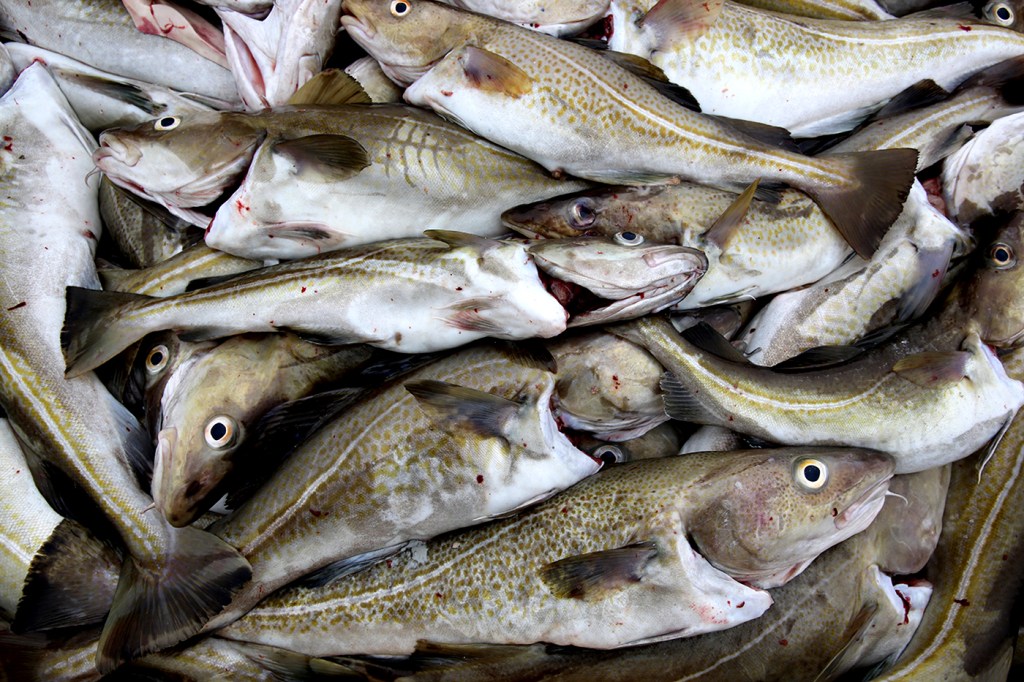Treating Gulf of Maine cod as two distinct subpopulations could help fisheries management, Northeastern University Marine Science Center researchers find

Cod has long been a staple of the New England fishery, but this once-plentiful fish has declined in recent decades. Despite repeated attempts to rebuild the stock, assessments suggest that the species has not recovered, frustrating biologists and fishermen alike.
Although the species is managed as a single population, cod in the Gulf of Maine can be divided into two genetically-distinct groups. And according to a new study, understanding the unique behavior and lifecycles of these two groups may be the key to creating a better management strategy.

The researchers used the growth rings on otoliths, small structures inside a fish’s head, to tell the difference between winter-spawning cod and spring-spawning cod. Winter cod have a full year of growth before their first ring, while spring cod have only six months. Courtesy photo Micah Dean
“These subpopulations are dramatically different from one another,” says Micah Dean, a doctoral student at Northeastern’s Marine Science Center who led the study. “And the mix of these subpopulations changes over space and season, and over time. This sort of complexity needs to be accounted for.”
Incorporating the differences between these two groups into population models could improve management decisions, says Dean, who is also a senior biologist for the Massachusetts Division of Marine Fisheries. And those decisions are vital to the survival and recovery of the fishery.
Both fisheries managers and fishermen have known that groups of cod in the Gulf of Maine gather to release and fertilize eggs twice each year, when the bottom temperatures are between 6 and 8 degrees Celsius (42.8 and 46.4 degrees Fahrenheit). In the last decade, researchers have confirmed that the fish spawning in May and June are distinct from the fish spawning in November and December. But there hasn’t been a clear way to incorporate this information into management strategies, so the animals have continued to be grouped together.
“The current stock assessments for Gulf of Maine cod assume that the population is one single, homogeneous unit,” Dean says. “All stock assessment models have to make gross oversimplifications. But sometimes those simplifications can create inaccuracies.”
Dean and his colleagues set out to determine if ignoring any differences between the subpopulations could be leading to flawed management decisions.

The oldest, largest fish in a population usually produce the most offspring, says Jonathan Grabowski, a Northeastern professor of marine and environmental sciences. But this new research suggests that the largest spring-spawning cod are not contributing to the population. Northeastern file photo
The researchers determined that they could tell the difference between spring-spawning cod and winter-spawning cod using a small structure inside the fish’s head, called an otolith. Otoliths help cod with orientation and direction in the water, and they are marked by annual growth rings, laid down when the temperatures get frigid. Winter cod have a full year of growth before their first ring, while spring cod have only six months.
Once the researchers had a reliable way to tell the two groups apart, they applied it in earnest. Dean and his colleagues examined over 1,600 otoliths, which had been collected during two scientific survey periods, the first between the years of 2003 and 2007 and the second between 2016 to 2019.
They found several important differences between the two subpopulations, but one result was particularly surprising.
The oldest, largest fish in the population seemed to be spring cod, which spent more of their time in areas of the Gulf of Maine that are closed to fishing. Old, large fish are usually considered the most important to protect in a population, because they contribute the most offspring. But the majority of the young fish caught in recent years were winter cod.
“You see this strong shift over time away from spring spawners to winter spawners,” says Jonathan Grabowski, a professor of marine and environmental sciences at Northeastern who worked on the study. “That’s pretty wild, considering that the spring spawners seem to be in higher proportion in the closed areas. They’re surviving better, but our results suggest that they are not contributing to recruitment. It goes against what you would expect.”
In surveys conducted in the early 2000s, spring and winter cod were equally represented. But in the recent years, spring cod make up less than 20 percent of the total population. And the researchers aren’t entirely sure why.
Previous research has shown that there is less available habitat for cod larvae in spring, as well as less to eat. Water temperatures in the Gulf of Maine have been rising in recent years, which may be putting even more pressure on the spring-hatched juveniles, Dean says. It’s also possible that the decline in the number of spring cod has disrupted their mating behaviors, making it harder for the group to recover.
If the largest fish aren’t contributing to the population the way researchers expect them to, then the population may not grow at the predicted rates. Management strategies need to be re-evaluated to account for the differences between these populations, Dean says. Otherwise they might be making the problem worse.
“Gulf of Maine cod doesn’t have a great track record—the stock has been overfished for decades and hasn’t responded well to the management actions that we’ve put in place,” Dean says. “I’m really hopeful that this will uncover some pieces that were missing when we were managing and assessing the stock in the past.”
For media inquiries, please contact media@northeastern.edu.





